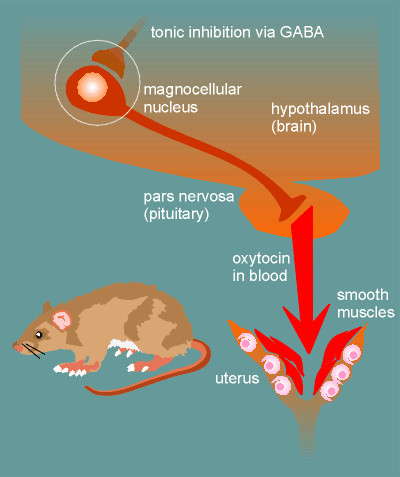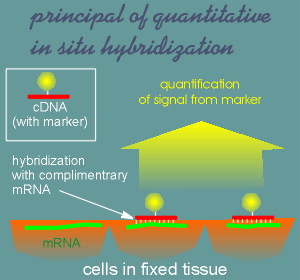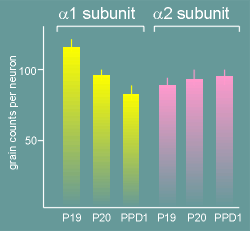 The system the Amsterdammers were studying was the oxytocinergic neuron of
the magnocellular system of the rat.
The system the Amsterdammers were studying was the oxytocinergic neuron of
the magnocellular system of the rat.Some studies in Amsterdam have illustrated the potential importance of the composition of GABAa receptors to physiological function.
 The system the Amsterdammers were studying was the oxytocinergic neuron of
the magnocellular system of the rat.
The system the Amsterdammers were studying was the oxytocinergic neuron of
the magnocellular system of the rat.
This neuron produces the peptide hormone oxytocin.
The cell body of the oxytocinergic neuron is in the one of the so-called magnocellular nuculi in the hypothalamus of the brain.
The terminals of the oxytocinergic neurons are in the pars nervosa of the pituitary gland.
Here the oxytocin is released to the blood.
One of the (many) targets for oxytocin is the smooth muscles lining the uterus.
Oxytocin causes muscle contractions and is believed to be involved in the process of parturition (the act of bring forth young).
The Amsterdam researchers knew that there was, within the magnocellular nucleus, a tonic inhibition of the oxytocinergic neuron brought about through GABA.
They wanted to know what type of GABAa receptor was involved in this inhibition.
 Their approach was to remove the brain, treat
the brain tissue with fixatives and then apply quantitative in situ hybridization.
Their approach was to remove the brain, treat
the brain tissue with fixatives and then apply quantitative in situ hybridization.
For this purpose they had specific cDNA probes for various alpha subunits of the GABAa receptor.
Their probes were radioactive and thus they could quantify the binding of probe through autoradioagraphy (counting silver grains above the neurons).
They were interested in which GABAa subunits were expressed in the magnocellular nucleus (and thus probably by the oxytocinergic neuron).
 The results......at about the time of parturition (pregnancy day 20, P20)
there was a decrease in the amount of mRNA for the alpha1 subunit.
The results......at about the time of parturition (pregnancy day 20, P20)
there was a decrease in the amount of mRNA for the alpha1 subunit.
This decrease could be further seen in post-partum day 1 (PPD1).
Why might this be important? Because a GABAa receptor with alpha1 is known to be far more sensitive to potentiation through neurosteroids than a GABAa receptor with alpha2.
With the decrease in alpha1 subunit receptors with the alpha 2 subunit will become more important in defining the response to GABA.
The Amsterdammers believe that just before parturition receptors possessing an alpha 2 subunit becomes more prevalent.
These receptors are less sensitive to endogenous neurosteroids and thus the tonic inhibition by the GABAergic system falls away.
Consequently, oxytocin is released to participate in parturition.
Brussarad et al. Neuron 19: 1103-1114 (1997).